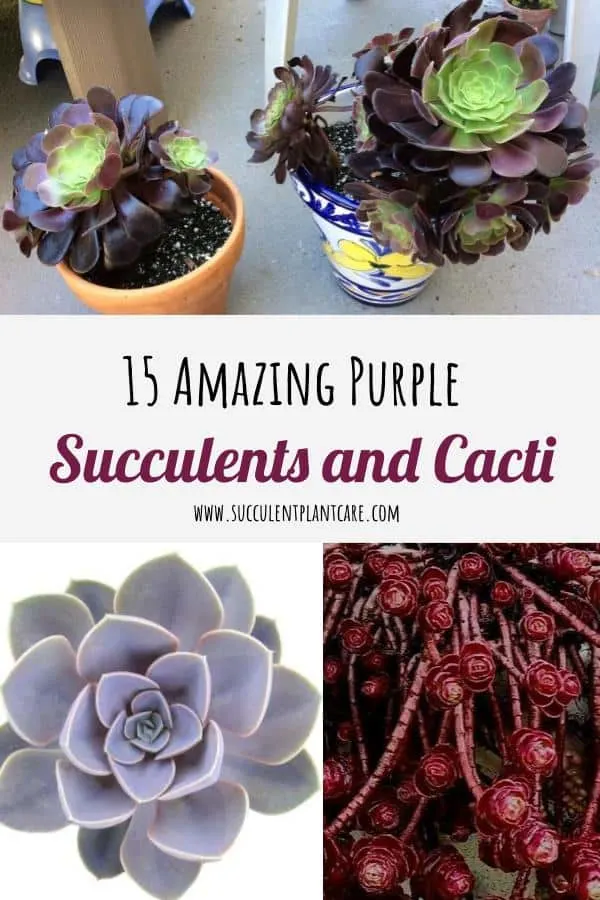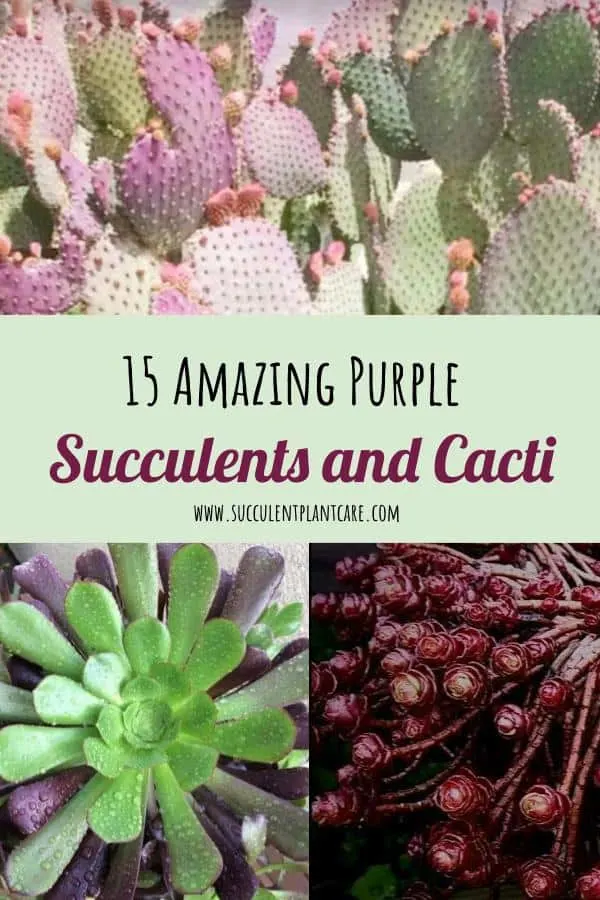Whether you’re looking for purple succulents for an upcoming event or for maybe for a ‘Gothic’ garden theme, or simply to place in a container garden, you won’t come up short with all the choices that are available to us. Succulents come in a variety of shapes, sizes, textures and colors, and purple succulents are just one of them.
Purple succulents are very popular not only because they are attractive but also because they are very versatile. Purple succulents and cacti look great in container gardens and when planted in the ground. They truly add a vibrancy of color to your garden space. Below are the top purple succulents and cacti to choose from.
Echeverias are one of the best choices if you’re looking for succulents in the purple hues. Echeverias have a wide selection of pink succulents to choose from. Below are some of the more popular ones (and there are plenty more):

Echeveria ‘Black Prince’
This beautiful and very popular echeveria has gorgeous dark green, deep purple, almost black leaves. Upon closer inspection, you will catch a tinge of yellowish green in the center of the rosette which spreads outward to the tips of the leaves. The dark purple color intensifies and darkens with more sun exposure. The plant will turn a pale purple or green when kept in the shade. The leaves are thick, succulent and wide with pointy tips. It produces dark red flowers which provide a striking contrast to its dark foliage. Echeveria ‘Black Prince’ is a hybrid of two plants: Echeveria shaviana and Echeveria affinis.
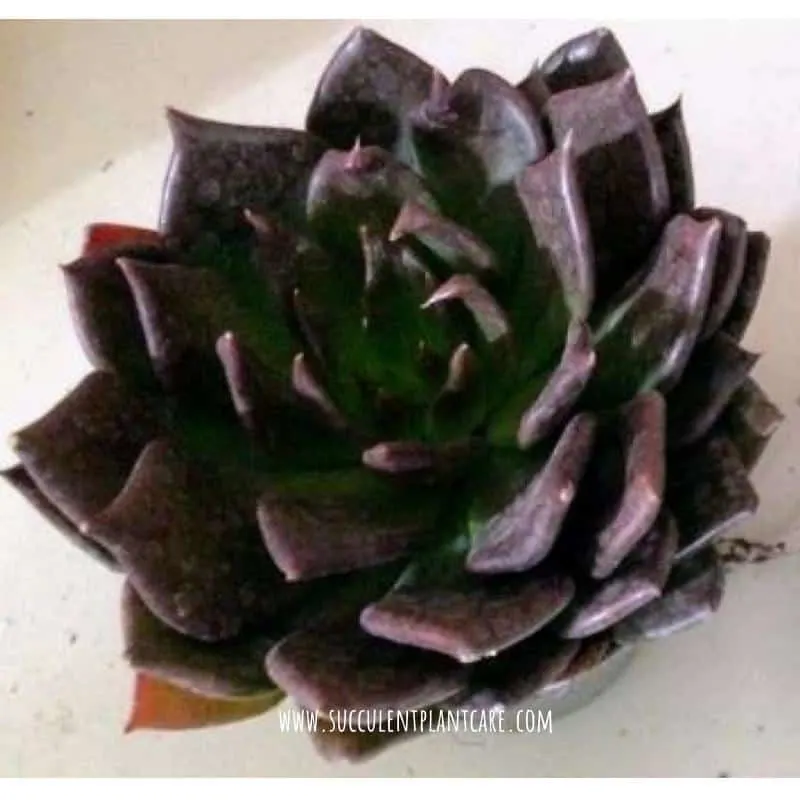
Echeveria ‘Shaviana’ Pink Frills
Native to Mexico, this echeveria has blue-gray frilly leaves with purplish-pink margins. The leaves are wavy and appear wrinkled, giving them a unique appearance. The pinkish-purple color on the margin of the leaves become more pronounced when the plant is exposed to more light. In the shade, it stays a subdued tone of blue-gray. Blooms are pink and very attractive. The flowers are pink and showy and appear around late summer.
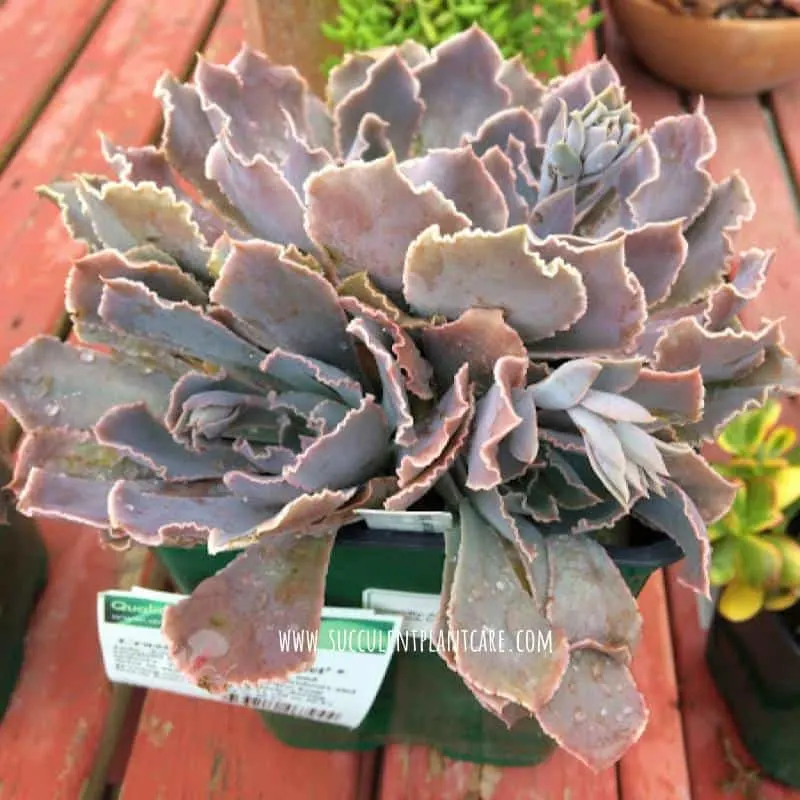
Echeveria Perle Von Nuremberg
A very popular hybrid echeveria because of its beauty and hardiness. Rosette shaped leaves that are grayish-blue with a touch of purple and pinks. The purple and pink hues intensify with the amount of sunlight it receives. It produces attractive bright coral pink flowers. This echeveria prefers a bright location and will do well in full sun or partial shade with plenty of sunlight. Needs a well-draining soil.
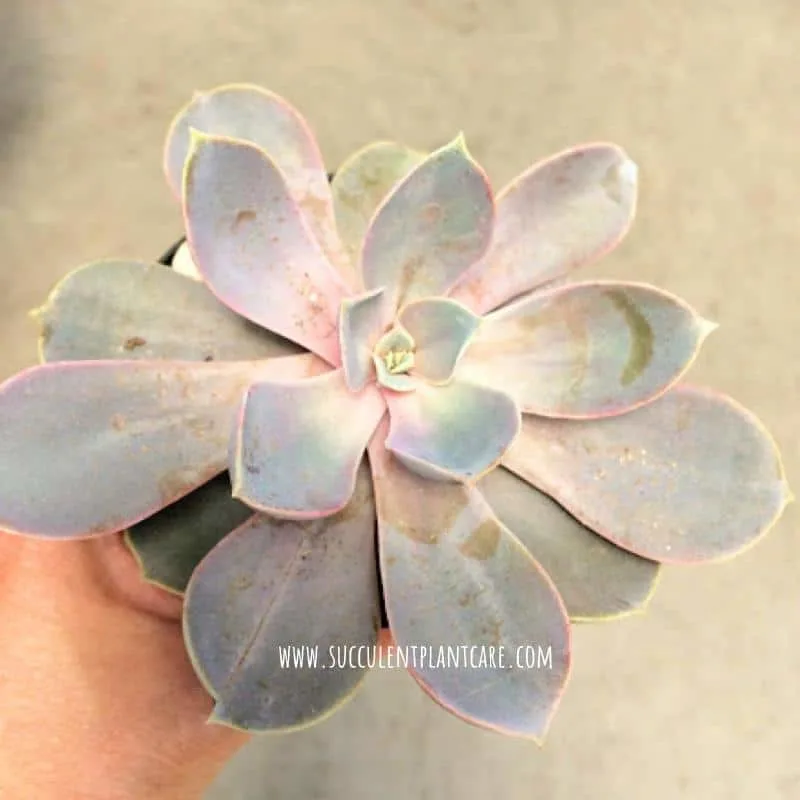
Sempervivum ‘Desert Bloom’
This colorful hens and chicks have leaves in shades of green, yellow, brown, pink and purple. The tips of the leaves are tinged with red, while the center of the leaves are purple-pink in color. The margins of the leaves are lined with little thin white hairs. The purple color intensifies when exposed to the cold during the winter months. These are easily propagated by separating the pups from the mother plant. Blooms are light pink in color and appear in the summertime.
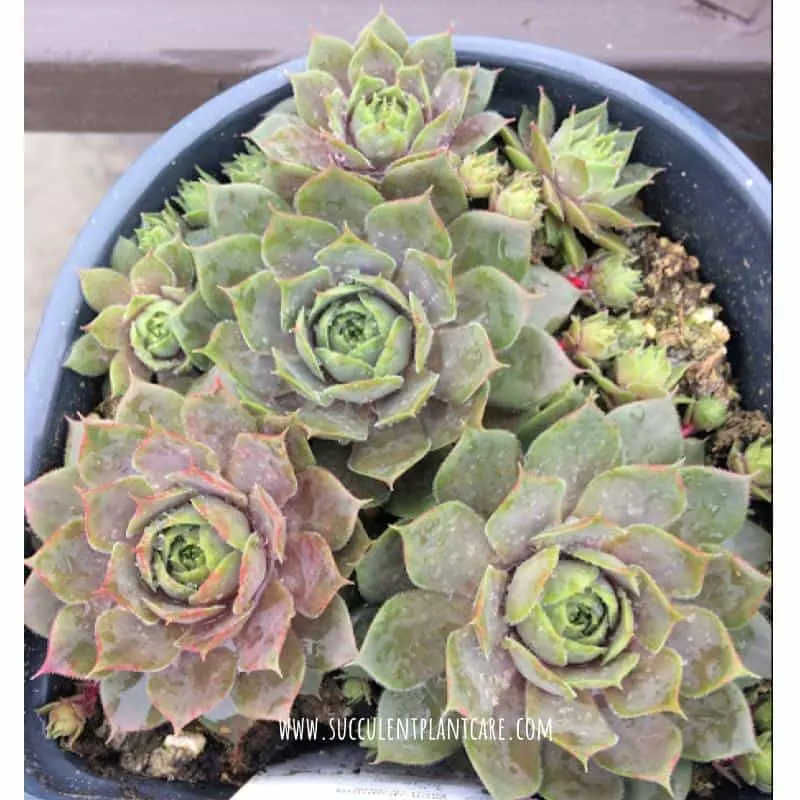
Aeonium Arboreum ‘Zwartkop’ (Black Rose)
Aeonium arboreum ‘Zwartkop’ (Black Rose, Black Tree Aeoniums) have beautiful dark purple, almost black foliage. It has striking rosettes that are made up of waxy, purple leaves. The rosettes look like flowers, giving it its common name ‘Black Rose’. They can grow up to over 3 ft. (91 cm) long. They really add contrast to your succulent garden because of their unique shape and color. To maintain its dark purple color, it needs plenty of sun.
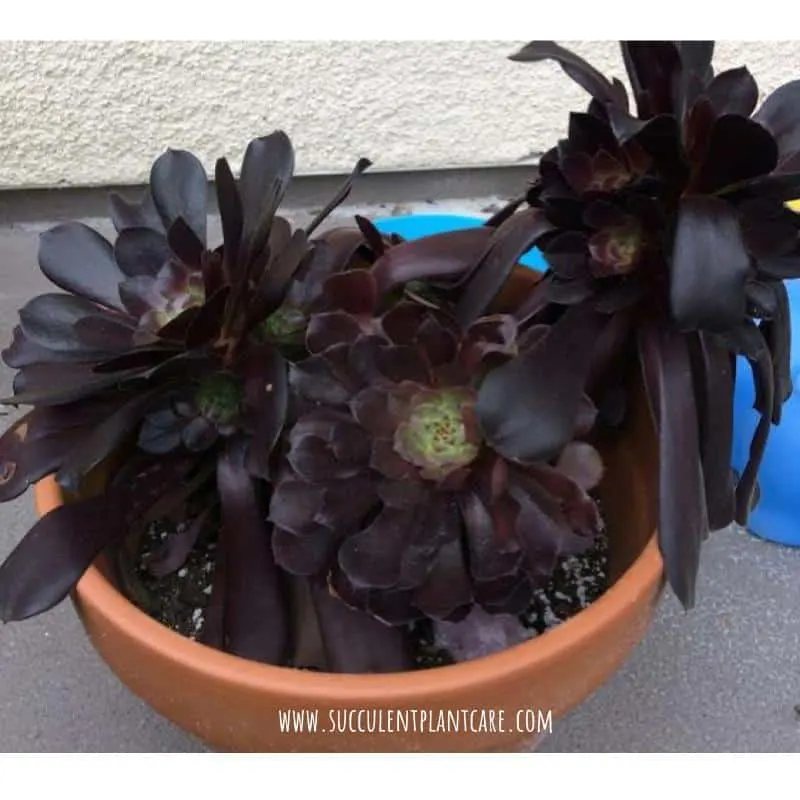
Aeonium Arboreum var. Atropurpureum (Purple Aeonium)
Aeonium arboreum var. atropurpureum (Purple Aeonium, Purple Rose) are similar to the more popular ‘Zwartkop’ but they have shorter stems and form smaller rosettes. The rosettes are made up of purple, dark purple, and reddish-purple leaves. These can grow up to around 2-3 ft. (61-91 cm) tall. They prefer light shade to full sun. Sun exposure brings out the purple hues of the plant.
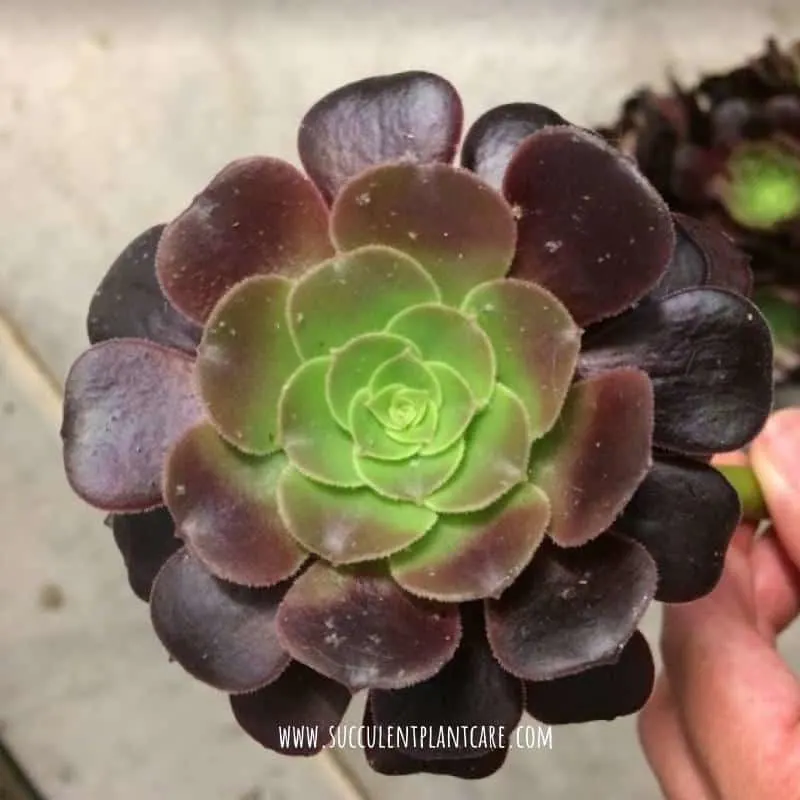
Aeonium Arboreum ‘Electra’ (Purple Pinwheel Aeonium)
Similar to the two Aeonium arboreum mentioned above, but the rosettes have shorter, fuller leaves. Foliage starts out green then turns purple overtime. Can tolerate partial shade to full sun. The sun brings out the purple tones of the plant. What’s unique about this aeonium is how it flowers. Unlike most aeoniums, it does not die back after it blooms. The blooms are also smaller and less showy and appear from the sides and undersides of the rosette. The flowers are yellow in color.
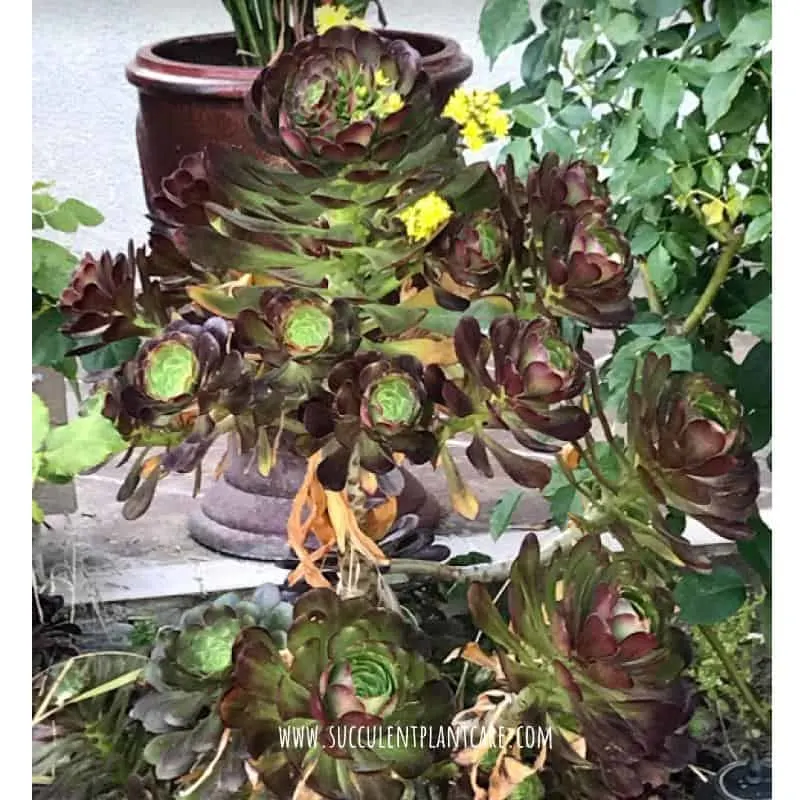
Anacampseros Rufescens (Sunrise Succulent)
Anacampseros Rufescens (Sunrise Succulent, Sand Rose) is a gorgeous, low-growing succulent plant native to South Africa. Its colorful foliage is in shades of green, yellow-green, purple and pink. Thin, white hairs can be found growing around the plant leaves. The plant forms clusters that spreads out overtime as it grows. This beautiful and unusual looking plant is a must if you are looking to bring a pop of color to your succulent arrangement. It is also a low-maintenance and easy-going plant.
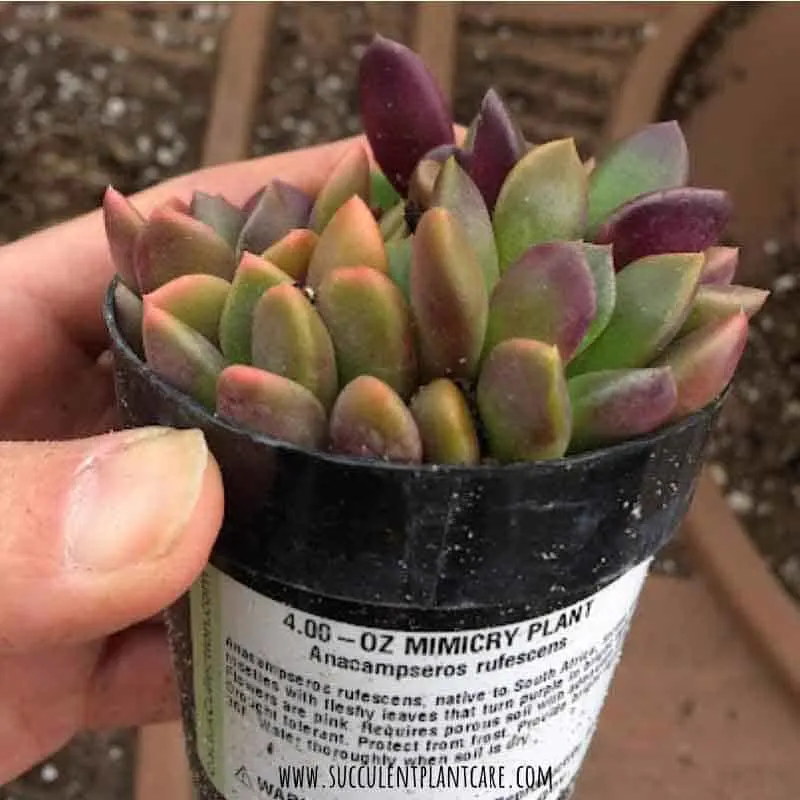
Sedum Spurium ‘Dragon’s Blood Stonecrop’
Sedum Spurium ‘Dragon’s Blood Stonecrop’ (Red Carpet) have leaves that are green, reddish-purple and deep burgundy in color depending on the season and lighting conditions. The deep purple color intensifies when exposed to more light and the cold weather. These are commonly used as ground cover because of its cold-hardy nature, but they are also popular as container plants. They are one of the cold-hardiest sedums out there. They produce star-shaped bright pink-reddish flowers and can grow up to 3-6 inches (1.18-2.36 cm) tall.

Kalanchoe Humilis (Desert Surprise)
Native to Africa, this unique looking kalanchoe has green leaves that are streaked with purple and maroon markings that appear horizontally across the leaves. The leaves are flat and wide and can grow up to 3-4 inches (7.6 to 10 cm) long. This plant is low-growing and bushy, and can reach 3 ft. (91 cm) tall. It produces light purple and green flowers with tall stalks. The purple markings are more intensified when exposed to the sun. The plant can tolerate light shade to full sun.
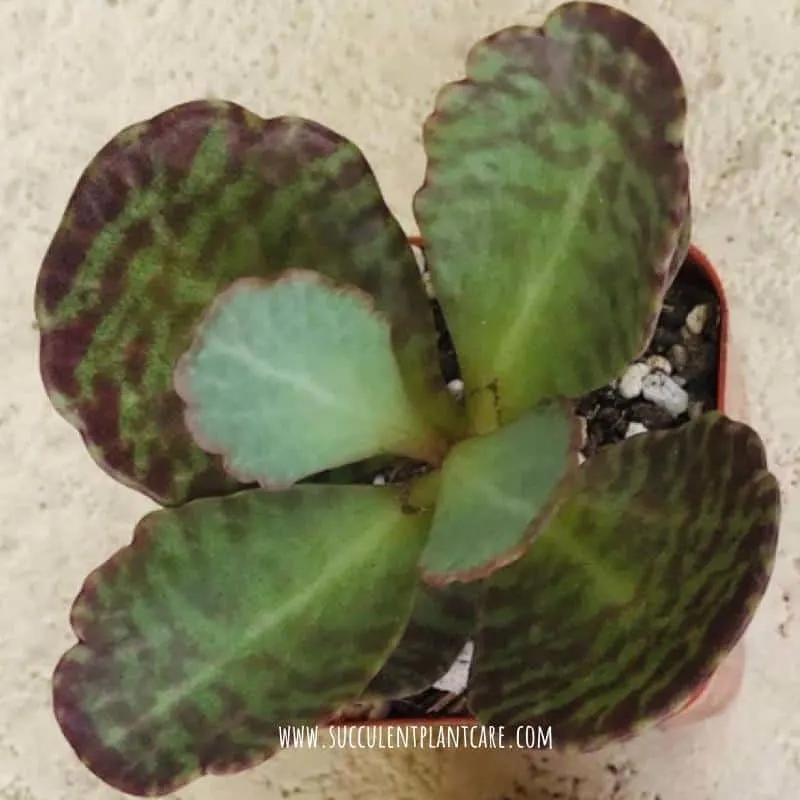
Lithops Optica ‘Rubra’
Native to Namibia, these are unique and also popular among lithops lovers because of their distinctive purple hue. It has beautiful, dark pink to deep purple bodies that grow in pairs. White flowers appear from the center between the two leaves. Lithops, also known as ‘living stones’, are very unique plants, and depending on where you live, can be quite rare and difficult to find. Not only are they unique, but they also require different growing conditions than most succulent plants. Withhold watering during the warmest time of the year in the summer months and in the middle of winter when the plant goes dormant.
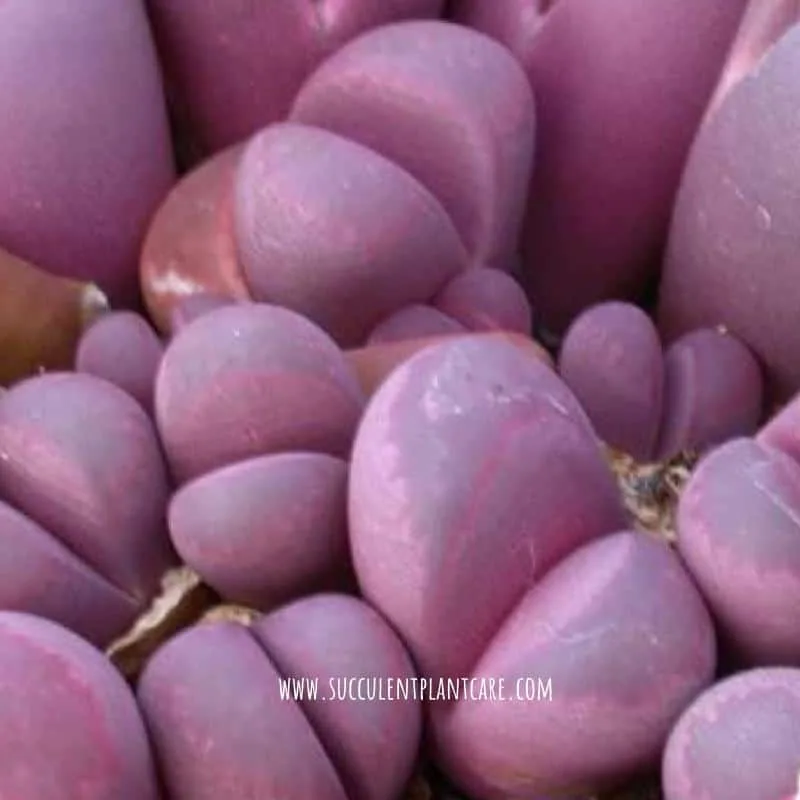
When looking for purple cacti to go in your landscape, prickly pears are a popular choice. Prickly pears are not only hardy plants, they also come in a variety of sizes, types and colors. They can be grown in the ground and in containers. When grown in-ground, they are known to spread quickly and are considered invasive in some areas. Here are some purple prickly pears you wouldn’t want to miss:
Opuntia Violacea var. Santa-rita (Opuntia Santa-rita)
Common names: Purple Prickly Pear, Santa Rita Prickly Pear
Native to Southern Arizona, New Mexico, some parts of Texas and Mexico, these prickly pears are becoming highly sought after because of their unique and colorful pads. These are one of the most popular purple prickly pears because of their distinctive purplish tones. The pads can range from green, blue-green, light purple to deep purple. The deep purple color intensifies when the plant is stressed, or when exposed to the cold with very little water. These can grow quite large, up to 4-6 ft (1.2-1.8 m) tall and 4-5 ft (1.2-1.5 m) wide. The flowers are cheery yellow in color and appear in the spring.
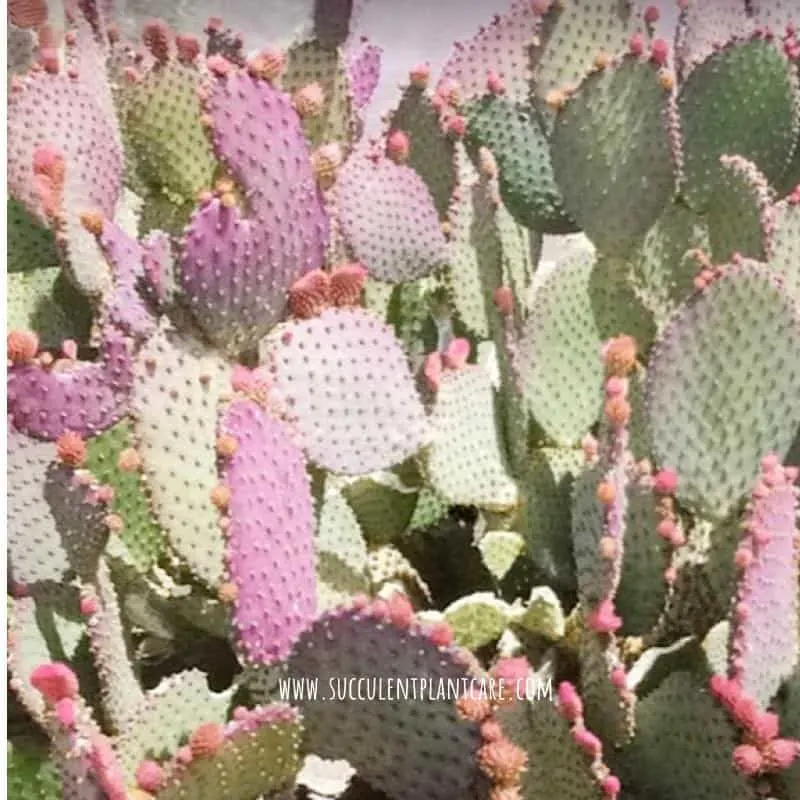
Opuntia Violacea var. Gosseliniana (Opuntia Gosseliniana)
Common names: Violet prickly pear, Milk-chocolate spine prickly pear
Smaller than its cousin, the purple prickly pear, Opuntia Gosseliniana grows up to about 2 ft (60 cm) tall and across. It is native to Arizona, some parts of California, and Sonora and Chihuahua, Mexico. The pads are tinged with pink, purple or deep purple. The sharp spines are usually brown in color. The plant produces yellow flowers during the late spring to summer months.
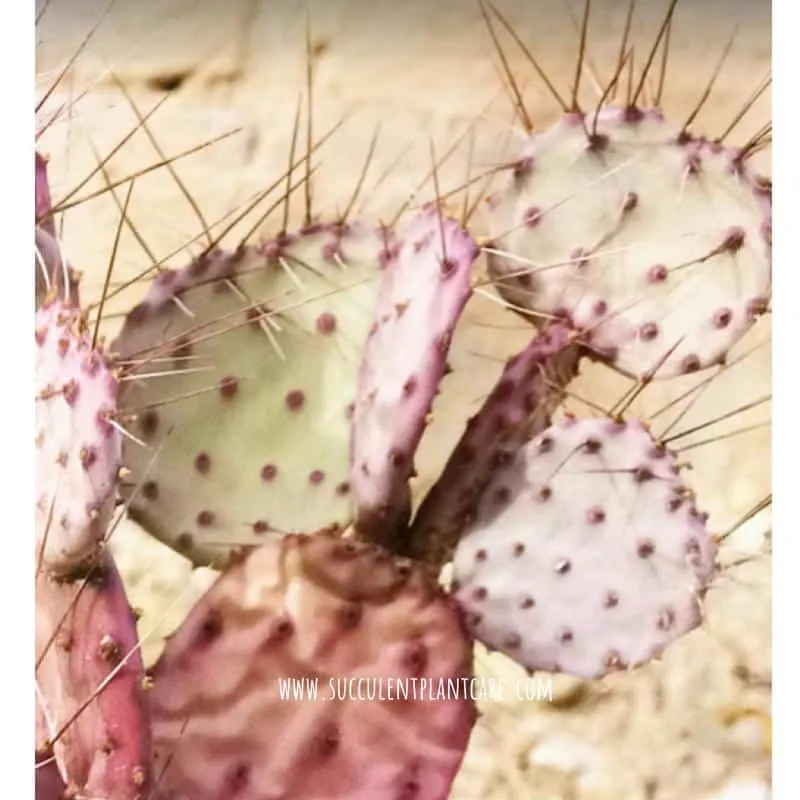
Opuntia Stenopetala
Common names: Tuna Colorado, Purple Fishnet Prickly Pear
Native to Northern Mexico, Opuntia Stenopetala is a unique kind of prickly pear. It can grow quite large when planted in the ground and can reach over a ft (30 cm) tall and 3-4 ft (0.9-1.2 m) wide. What’s unique about this plant is the purple-brown markings on the pads that are fishnet-patterned. These markings appear in the wintertime when the weather is at its coolest. The purple fishnet markings become more pronounced when the plant is stressed by cold and drought. These plants are cold hardy up to around 15 to 20 °F (-6.7 to -9°C). They produce striking bright orange flowers that appear during the spring and summer months.
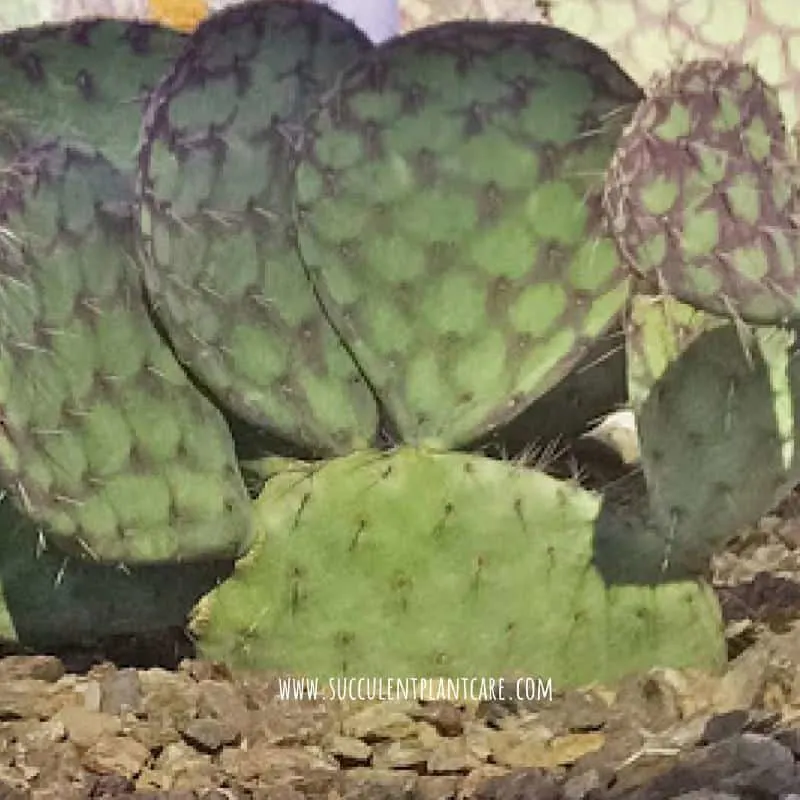
Opuntia Polyacantha ‘Dark Knight’ (Opuntia ‘Dark Knight’)
Common name: Dark Knight Prickly Pear
Native to the southwestern regions of the U.S. and northern Mexico, these prickly pears are more cold hardy than some of its purple prickly pear counterparts. They are cold hardy up to around -10°F (-23°C). The dark knight prickly pear is very attractive because of the purple pads that stay purple almost all year long. The purple pads turn to a deep purple, almost black color in the middle of winter. The sharp, long spines are mostly white in color. These produce beautiful, striking fuchsia and lavender flowers. These plants do not get very tall and often reach up to about 12 inches (30 cm) tall. They can be grown in the ground or in containers.
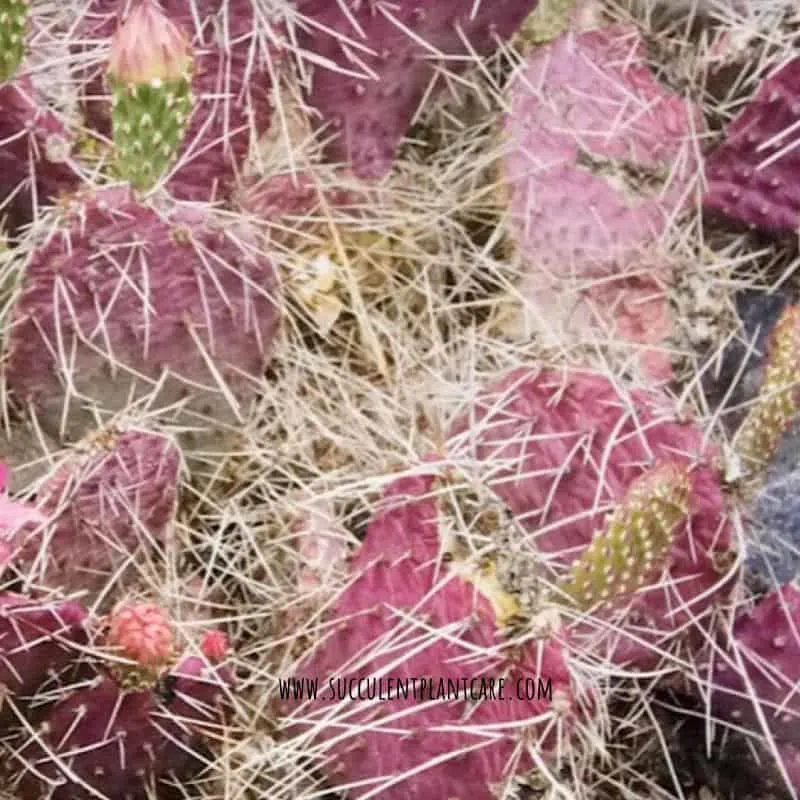
Prickly pear pictures obtained from The Gardener’s Guide to Cactus by Scott Calhoun
These are just some of the most popular purple succulents, and there are plenty more out there.
Take care not to be fooled by ‘fake’ purple succulents. These are those spray painted ones. If you are new to the succulent/cacti world, you may be duped into buying one of these spray-painted plants thinking you are getting a unique succulent plant. The paint will eventually come off as the plant grows and sheds its old leaves. If you happen to own of these, don’t be disappointed to learn that they are not the color that you thought they were because you will soon see the true beauty of the plant underneath.
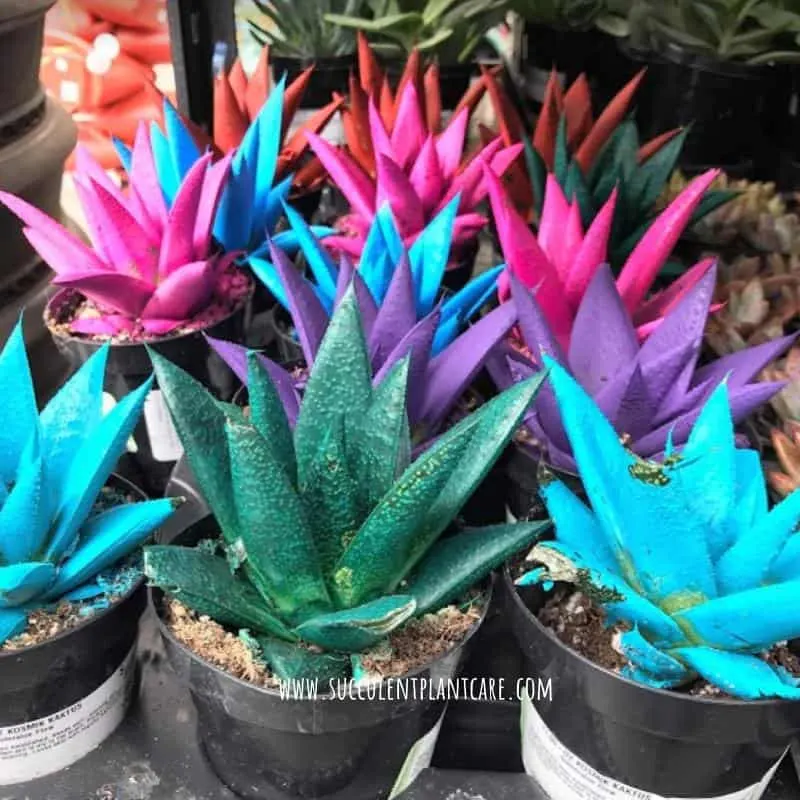
Spray painted succulents. Don’t be fooled by these colors because they are fake.
These are just some of the most popular purple succulents out there, and there are plenty more. Wondering where to find some of these purple beauties? Visit my resource page for recommendations on where to purchase these and other succulents and cacti online.
Also very popular and pair really well with purple succulents are pink succulents. Click on my post “15 Stunning Pink Succulents You Would Love” to find out more.
Pin this to save for later or share with others now!
